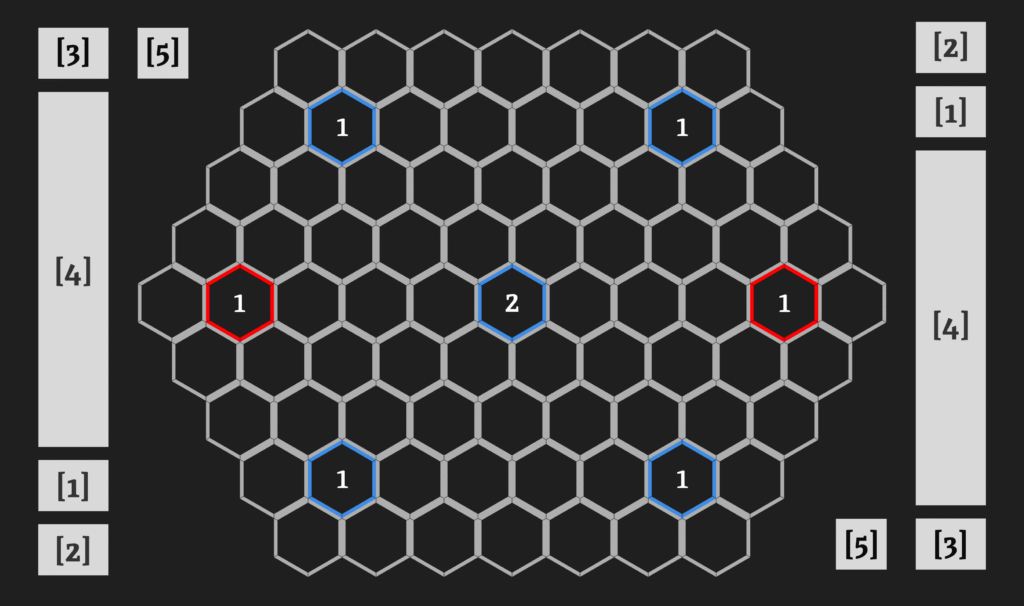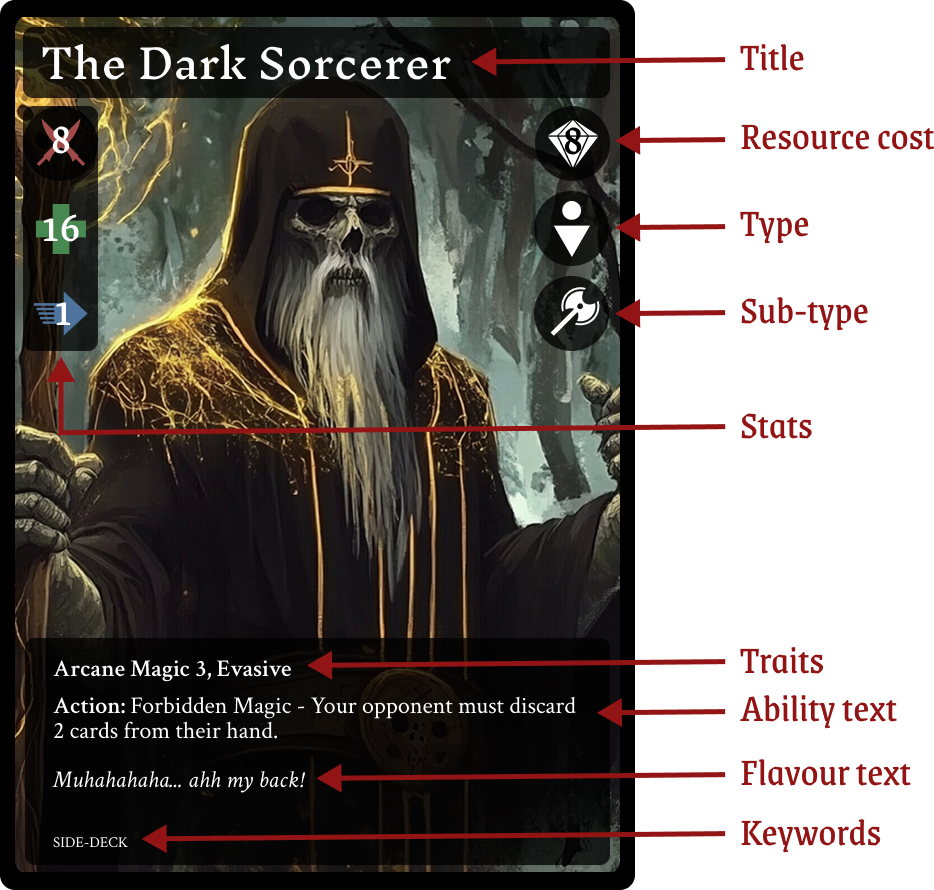Getting Started
In TSF two players fight for dominance of the hex-grid battlefield aiming to eliminate both of the opponent’s leaders. Capturing resource points is of key importance as they provide the resources needed to deploy units on to the field and cast effect-cards that can turn the tide in your favour.
The rules below explain exactly how this works.
Playing Materials
Leader Cards
Main Deck
The Main Deck (or just Deck) consists of 40 to 60 cards.
It can contain up to three copies of each card. Cards marked with the UNIQUE Keyword may only be included once each.
Side Deck
The Side Deck consists of 0 to 20 cards. It follows the same rules as the Main Deck in terms of card copies.
The Side Deck may only contain cards with the SIDE-DECK Keyword. SIDE-DECK Cards may not be included in the Main Deck.
The Side Deck can only be accessed via Card Abilities unless noted otherwise.
Markers
Different markers to represent resources, damage, status effects etc.
Game Board
The game takes place on a hex-board as seen on the right. It contains the following areas:
[1] Deck – Place your Deck here
[2] Side-Deck – Place your Side Deck here
[3] Graveyard – Discarded cards are placed here
[4] Effect Area – Effect cards are placed here
[5] Resource Pool – Resource markers are placed here
The coloured hexes are Resource-Fields. The numbers indicate their value.

Game Setup
Initial Setup
1) Prepare the Game Board and each players Deck
2) Both players draw 6 cards from their Deck
3) Flip a coin. The winner chooses who goes first
Leader Placement and Redraws
Starting Player
– Places leader cards next to one of the red resource fields (it is now controlled by the starting player)
– May redraw up to 2 cards
Second Player
– Places leader cards next to the other red resource field (it is now controlled by the second player)
– May redraw up to 2 cards
– Receives special resource token (can be spent anytime for +2 resources, then discarded)
Playing the Game
After setting up the game the starting player begins by taking their first turn. The players take alternating turns until one has won.
1) Resource Phase
Place 1 resource marker in your resource pool for each resource-field you control (+2 for the field at the centre).
2) Draw Phase
Draw 1 card from your Deck
3) Main Phase I
Play any number of cards from your hand (See Playing a Card).
4) Action Phase
Each unit you control may take 2 actions.
5) Main Phase II
Play any number of cards from your hand (See Playing a Card).
6) Cleanup Phase
Handle Status Effects for every Unit
Handle Traits for every Unit
Remove all resource markers from your resource pool
Cards
Anatomy of a card
[Resource cost] – Amount of resources you must pay to play the card
[Type and Subtype] – Classification that affects how the card is used
[Stats (Unit only)] – A units ATK, HP and Speed values
[Traits] – Keywords that give the card special properties
[Ability text] – Describes what abilities a card has
[Keywords] – Tags used to group cards by theme or mechanics

Playing a card
You may only play cards from your hand during one of your Main Phases. To play a card remove <resource-cost> resource markers from your resource pool and follow the instructions given under Card-types
Card Types

Unit Card
Units are the cards that act on the game-board. They can be placed on or next to controlled resource-fields. Each unit can take an action and move during the Action-phase. Two units may not occupy the same hex-field.

Melee
Melee Units have an attack-range of 1 and are the only unit-type that can take reaction-strikes.

Ranged
Ranged Units have an attack-range of 2. This means they can’t attack adjacent units.

Artillery
Artillery Units have an attack-range of 2 to 3.

Effect Card
Effect cards affect the game in a multitude of ways as noted on the card. They are placed face-down in the Effect-Area. When a card can be activated depends on it’s subtype.

Slow
Slow Effect-cards can only be activated during the controlling player’s own turn and are discarded after activation.

Permanent
Permanent Effect-cards can only be activated during the controlling player’s own turn and but aren’t discarded unless specifically stated.

Fast
Fast Effect-cards can be activated at any time, including the opposing player’s turn and can interrupt their actions (See Effect-chains for details about how to handle different cases of this). The card is discarded after activation.
Abilities
Abilities affect the game in many different ways as described in their ability-text. Whenever ability-text and other rules contradict each other the ability takes precedence.
Activating Abilities
Abilities can be activated under different conditions, noted in bold before the ability description:
Action – The unit must take an action to activate this ability (It uses its action to activate it).
Reaction – Can be triggered when the given condition is met
Passive – Always active
If no condition is listed, the ability can be used at any time (unless restricted by other rules, such as Slow Effects only being usable on your turn)
Some abilities require you to spend resources to use them, shown in brackets after the activation condition (e.g. Action (2) )
Actions and Combat
Actions
Each Unit can take one of the following actions per turn. Units may not act in the same turn they were placed on the board.
Extra Move
Move the Unit up to <Speed> hex-fields
Capture
A Unit standing on a resource field may use an action to capture it. It is now controlled by the active player
Attack
Combat
HP und Death
When a Unit takes damage place a corresponding number of damage markers on to it. If its damage markers equal or exceed its HP it dies. Place it on the controlling player’s graveyard immediately. All Effect Cards attached to the unit are also immediately discarded.
Reaction Strikes
Once per turn after a Melee Unit is hit by an attack it may take a reaction-strike. When doing so it attacks the unit it was attacked by.